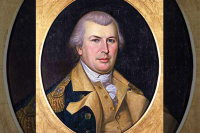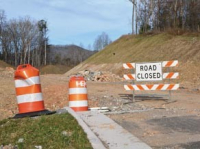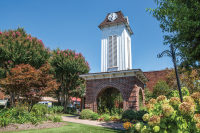New courthouse landscape to be less lush, more spartan
 A new landscape plan for the Haywood County historic courthouse is mostly devoid of large shade trees, in stark contrast to the many stately sugar maples that graced the lawn until recently. Instead, it opts for just a handful of midsized trees.
A new landscape plan for the Haywood County historic courthouse is mostly devoid of large shade trees, in stark contrast to the many stately sugar maples that graced the lawn until recently. Instead, it opts for just a handful of midsized trees.
County commissioners hastily voted to cut down the trees earlier this year without public input, citing a variety of reasons ranging from trouble getting grass to grow underneath to the danger posed by falling limbs. The now-denuded courthouse lawn was met with chagrin by some, but commissioners pledged a better, more attractive landscaping plan would follow.
Commissioners this week approved a landscaping plan for the courthouse, but according to two landscape architects, it leaves something to be desired.
While the trees selected to decorate the courthouse lawn will offer color during the year, the design lacks large shade trees — the reason the grassy area became a hotspot for anyone looking to cool off while downtown during the summer.
“They should put some of the canopy back,” said Wayne Villavaso, a landscape architect from Maggie Valley. “Try to add a couple of the maples in.”
Related Items
The plan calls for just two trees in front of the courthouse, namely Yoshino Cherry trees, which grow to a maximum height of 50 feet.
Along the left side of the courthouse facing Depot Street, the plan calls for six Kousa Dogwood, which grow to a height of 25 feet. It also has numerous shrubs lining the walkway and a couple more trees heading toward the justice center.
It includes only one sugar maple set back on the right side of the historic courthouse, between it and the new justice center.
After reviewing the design, Villavaso said the county could easily add a couple of sugar maples along the street in front of the courthouse. The trees would provide shade without blocking the view of the courthouse or clashing with the rest of the design.
“They can put in the maples trees and still have a nice lawn,” Villavaso said, adding that he liked the plan otherwise.
Philan Medford, a tree advocate and pedestrian activist, also suggested that the county place maples along the street for shade. The trees would grow tall and could be limbed up and still allow unobstructed views of the courthouse from the sidewalk or street.
“What I regret is no shade trees on the street,” Medford said. “It is going to be hot.”
Medford called the absence of shade trees “stupid.”
The two landscape architects disagreed about the county’s choice of tree species.
Villavaso said he liked the choice because of their colorful nature.
“I think they are fine actually. There is lots of color,” Villavaso said. “This is a good effort.”
However, Daniel Hyatt, a landscape architect in Waynesville, said he felt the choice of trees was too exotic for Haywood County and none of them would provide the shade people have enjoyed and were accustomed too with the maples.
“Surely there are at least regionally native plants that would have some character,” he said.
By placing the cherry trees in the middle of the lawn instead of closer to the edge, people will also be less inclined to hang out on the lawn as is a longstanding custom during summer festivals.
“Trees framing a lawn invite use, ease mowing and make the space feel longer,” Hyatt said.
And because of the way cherry trees’ limbs fall, people will not be able to sit beneath them for shade, he said.
Assessing the options
Commissioners got their first look at at the landscaping plan last week, when County Maintenance Director Dale Burris presented the commissioners with three design options for the courthouse lawn. All three included the same tree species but had slightly different placements.
A committee of a dozen people with varying backgrounds, including arborists, concocted three different landscaping options. The committee did not include any certified landscape architects, however.
The two that were not picked included more Yoshino cherry trees lining the walkway up to the courthouse entrance, one of which included elevated planters for flowers and another that did not.
But commissioners thought the options that included more trees might make the lawn look cluttered.
“If we go back and busy it back up, we are defeating what we tried to do,” said Commissioner Mike Sorrells.
Board members also thought their final choice would be best for festivals, particular the Folkmoot International Festival when flags are hung from the courthouse.
“I do think number three does lend itself more when we have Folkmoot,” said Commissioner Kevin Ensley.
Burris said he did not care which plan was ultimately chosen as long as the county moved quickly to plant something on the barren courthouse law. Out of everyone, he said, employees in the facilities and maintenance department are the most anxious to replace the cut down maples.
“Maintenance staff … wants to get this back to the way it used to be probably more than anybody else,” he said. “They don’t take much pride in a mud hole.”
The new landscape plan also includes the relocation of the flagpole outside the courthouse. The pole currently sits on the right side, closest to the Haywood County justice center. According to tradition, it should stand on the left side.
The commissioners agreed to replace the current flagpole with a 40-foot pole just to the right of the historic courthouse.
The appearance of the courthouse lawn has been a hot topic around the county since February when the commissioners first gave the orders to chop down the 11 sugar maples and one evergreen that stood around the courthouse. The loss of the trees came as a surprise to many when they saw the sugar maples being cut down in the days following the board’s decision.
An arborist’s report said the trees were diseased and posed a liability problem for the county, prompting the commissioners to order them to be swiftly cut down. The courthouse lawn has sat bare for a couple months. Workers will finish grinding up the trees’ stumps this week and then the re-landscaping can begin.
“Once they are finished, this should begin to move very rapidly,” Swanger said.
Committee members included Jonathan Yates, horticulturist with town of Waynesville; Bill Skelton with Haywood County Extension Service director; Tim Matthews, certified arborist with the county extension office; Dwayne Vigil, N.C. Forest Service supervisor; Buffy Phillips, director of Downtown Waynesville Association; Sherri Rogers, county register of deeds, Julie Davis, county finance director, Dale Burris, county maintenance director, County Commission Chairman Swanger and County Manager Marty Stamey.
County workers will receive help from the Haywood Community College students and George Thomas, director of Haywood Community College horticulture program.
Charles Boyd, a licensed landscape contractor and owner of WNC Landscaping Service, will donate the dogwoods and sugar maple to the county. The county will try to find the other species at wholesale price or try to get them donated as well.









